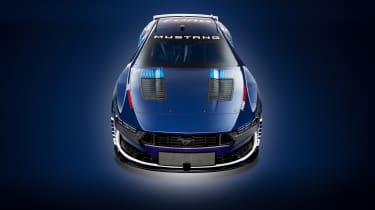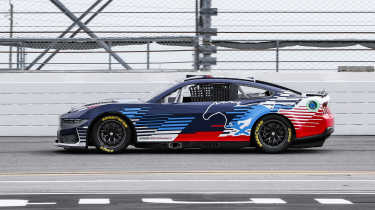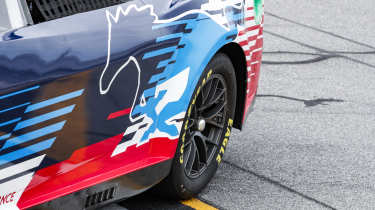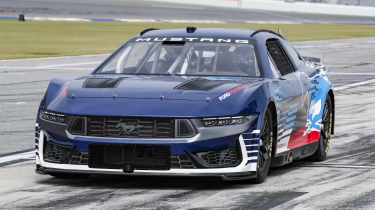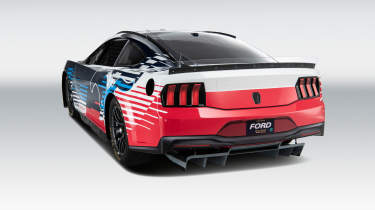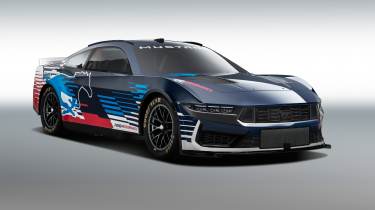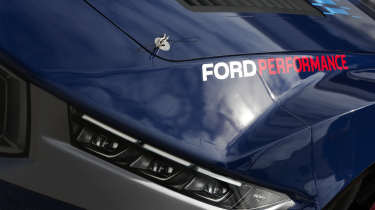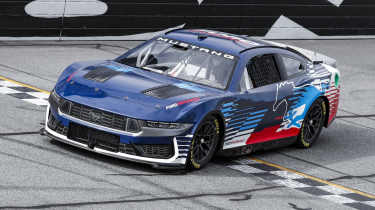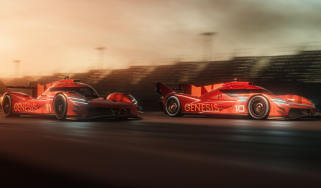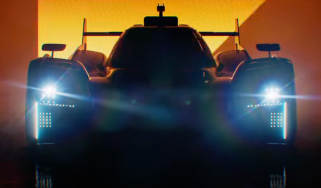The anatomy of a NASCAR Cup car: under the skin of the 200mph V8 racer
The thrill-packed NASCAR Cup Series has undergone arguably its biggest ever shake-up with the introduction of the Next Gen car. We get up close with Ford’s contender, the Mustang Dark Horse
Let’s get one thing clear from the start: what you’re looking at here isn’t a ‘NASCAR’, and referring to it as such would set eyelids twitching from Chigagoland to Talladega. NASCAR, or the National Association for Stock Car Auto Racing, is the governing body that sanctions and operates some of America’s biggest car racing series, and its flagship is the NASCAR Cup Series, in which an average of 30-plus drivers, more than a dozen teams and three major manufacturers compete over 36 race weekends between February and November.
So the Ford Mustang Dark Horse you see here isn’t a NASCAR, but a Cup car – or, to use an old term that has hung around long after the introduction of purpose-built racing cars, a ‘stock’ car. Ford’s Dark Horse took 12 race wins in 2024 and Team Penske Ford driver Joey Logano the drivers’ title. It’s high time evo got under the skin of one of the world’s fastest competition cars.
> How NASCAR is dull, confusing and utterly captivating all at once
1948 - 2025
NASCAR celebrated its 75th anniversary in 2023, making it two years older even than Formula 1. And just as with F1, while the concept is still the same and the series returns to several of the same circuits it used in its inaugural year, today’s cars are very different from those used in the early years. In fact, NASCAR’s roots sprouted well before it became a sanctioned series, and they were somewhat less auspicious than those of F1 –
the first stock car racers were the bootleggers who modified their road cars to evade authorities during Prohibition…
Stock cars have more clearly defined generations than most series, with fewer rule changes over the years affecting the shape and performance of the cars. Today’s ‘Next Gen’ Cup cars represent only the seventh defined era in the sport’s history, and only once has a generation – and therefore its rule-set and the way the cars look and perform – lasted less than a decade.
Early stock cars were just that: post-war road cars raced more or less as they came, with token gestures towards safety such as rolling the windows down and taping up lights to avoid scattering tracks with broken glass. Second-generation cars, from 1965 to 1980, took things further as manufacturers cottoned on to the famous ‘win on Sunday, sell on Monday’ creed and ploughed enormous money into the sport.
It was during this period that NASCAR saw a rapid increase in performance and innovation, most notably with famous homologation specials such as the Dodge Charger Daytona and Plymouth Superbird, with their wind-cheating nose-cones and carry-handle rear wings. These were the first 200mph stock cars, and they prompted the first use of restrictor plates to limit intake air and keep power figures under control.
The last generation to just about fit the original definition of a ‘stock’ car lasted from 1981 until 1991. Post-oil-crisis models were more compact than before but, with V8 engines and rear-wheel-drive platforms still prevalent in the market, they still made a suitable basis for transformation. Teams compensated for the brick-like aero of some carry-over 1970s designs by fitting large, bubble-style windows that spanned the roof and bootlid, a fix that became less necessary as the road cars themselves adopted the curvier stylings of the 1990s.
Not so stock
From 1992 onwards is when the Cup Series moved effectively to purpose-built race cars. Bodies were now custom-made, with glassfibre front and rear sections only vaguely resembling the production cars they were nominally based upon, and honed in the wind tunnel, not just to facilitate 200mph speeds but also to ensure the cars remained stable. Aerodynamics became a way of mitigating accidents, too: 1994 was the first year that roof-flaps were implemented, flipping up if a car got sideways or went backwards to prevent airflow from scooping the car into the air and potentially sending it into the stands.
The series’ fifth generation arrived in 2007 with the ‘Car of Tomorrow’, with more changes to increase safety, limit costs and increase drag – the addition of a rear wing proved one of the series’ less popular features and was phased out in 2010.
Fuel injection was introduced in 2012, but the Car of Tomorrow became the Car of Yesterday in 2013 when the sixth-generation car was introduced. Gen six was most notable for its greater freedom in body styles to help manufacturers more closely align stock cars with their road-going counterparts, a series of aero upgrades aimed at improving the racing, and a McLaren-designed digital dash from 2016, replacing the bank of analogue gauges used for the previous few decades.
Next Gen NASCAR
And so we come to the NASCAR Cup Series’ seventh generation, dubbed the Next Gen car. Introduced in 2022, Next Gen is one of the biggest changes the sport has seen since its inception more than 75 years ago, and certainly the most significant shake-up since the move away from factory bodies with the fourth-generation cars in 1992.
Next Gen is a comprehensive package of changes implemented for the same reasons most series change their rule-sets now and then: bolstering competition, improving safety, and an attempt to sprinkle a dose of marketing-friendly road-relevance on cars that have grown ever further from the original ‘stock’ concept.
It’s almost easier to list things that have remained the same, rather than the aspects that have changed: under the skin, this is still a front-engined, rear-drive, steel-spaceframe race car with a custom body made from a mix of stamped steel and carbon composites. The engine, too, remains a naturally aspirated V8 of 358 cubic inches, or 5.86 litres, while the sport still has a 3200lb (1451kg) minimum weight limit without driver and fuel, or 3400lb (1542kg) in race trim.
Nearly everything else has changed. The chassis is now a standardised component, designed by Dallara and NASCAR, built by a third party, and supplied to each team in three pieces. The old rear suspension set-up, comprising a solid axle hanging from trailing arms (colloquially dubbed ‘truck arms’ by those in the sport), has been consigned to the history books, with fully independent suspension (a double-wishbone arrangement, now matching the front end) used for the first time in the sport’s history, with four-way adjustable Öhlins dampers and Hyperco springs at all four corners.
The live axle and the old four-speed manual gearbox bolted to the engine have made way for a five-speed fully sequential transaxle from British firm Xtrac. And if the cars look broadly similar to those from a few years ago when plastered with vibrant sponsor logos, the reality couldn’t be further removed. Not only do they now rely more on underbody aerodynamics, with an underwing and rear diffuser, but the body itself is now square: over the previous two generations of cars, teams ran asymmetrical bodies designed to take advantage of the unique aerodynamic requirements encountered when a grid full of 40 cars turns left for five hundred miles.
Finally, 2022 saw the introduction of a new wheel and tyre combo. Out went fat, ’90s F1-style slicks on 15-inch steel wheels held on by five lug nuts, and in came 18-inch alloys wrapped in lower-profile rubber from the series’ sole tyre provider, Goodyear – and the wheels are now retained by centre-lock nuts, bringing Cup into line with most other international series.
Making a Cup car fast
‘When you look at these cars now in the garage area or on the racetrack, they look a lot more like the Mustang Dark Horse you can see in the showroom.’ Those are the words of Richard Johns, NASCAR performance leader at Ford Performance, on Ford’s latest Cup car. Johns is now in his tenth year at Ford and is one of the key figures behind the brand’s Next Gen programme, having been there ‘with a clean sheet of paper’ when Ford Performance began development on its car. ‘I work cross-functionally with our powertrain group, the vehicle dynamics group, and the simulation and data analytics aspects,’ he tells me.
The most significant change with Next Gen, from a team’s perspective, has been the new chassis, says Johns. ‘With gen six, every team manufactured its own chassis. There were obviously rules and limitations, but you had a greater degree of freedom, but now it’s the same for everybody.’
The new layout caused some unexpected engineering challenges, as drivers discovered early on that when the tyres burst after the car slid sideways at speed, the vehicle would become stuck on its ride-height-limiting rub-blocks, unable to move. The stiffness of the chassis had other side effects too – in early accidents, NASCAR discovered it was transferring concerning levels of load through to the driver, and the series has worked hard with teams to improve driver safety.
New rear suspension has brought greater adjustability, opening up camber and toe settings in a way the solid axles never allowed, but the cars also rely on more traditional NASCAR set-up techniques. Wedge, the practice of winding extra height into one side of the rear axle to change the balance of the car in both the chassis and aerodynamics, is still used – and you can often see crew members adjusting the car at mid-race pit stops.
Aerodynamics is another area the teams constantly tweak, albeit more at the factory than on track. ‘We have three different aero packages,’ explains Johns. ‘There’s a superspeedway package, one for short and intermediate tracks, and another for road courses [that’s traditional race circuits to those of us in Europe]. The biggest difference is that the superspeedway set-up has some over-body elements to help keep the cars rubber-side down. We’ll always try to find ways to shift the balance aerodynamically, but we have to be careful because adding downforce for road courses and short tracks can introduce extra drag on the superspeedways.’
Over the years, teams have built cars to ever tighter tolerances, and attention to detail is now more important than ever – especially given the standardised chassis, transmission and other components, resulting in fewer ways to find a competitive advantage.
Even the design of the body, one element where a manufacturer’s road car has an influence on the look of the racer, still has to conform to NASCAR rules – so behind the Dark Horse stickers and sharky front end there’s not actually much difference, aerodynamically speaking, to Chevrolet’s Camaro ZL1 or Toyota’s Camry XSE. ‘It’s been extremely difficult,’ says Johns, ‘particularly as each year of Next Gen we’ve submitted a new car and had to make a change. Luckily, for 2025 we have the same car, so we can really get into the details and keep refining it.’
An aerodynamic element unique to NASCAR is the aforementioned use of flaps to mitigate the risk of cars taking to the air in a spin or an accident. Like the rest of the car, these are constantly evolving. Johns notes that a new package arrived at Talladega last year, with a taller roof rail on the right-hand side of the car, a fabric piece in one of the roof flaps, and an extra skirt in the right rear arch, all wind-tunnel tested and double-checked to ensure it doesn’t affect each team’s aero performance relative to their rivals. And yes, NASCAR runs cars through a full 360 degrees, and even at different heights, in the wind tunnel; oval racing really is a different world.
Teams get through a fair number of cars in a season, even if you take accidents out of the equation. NASCAR allows seven chassis per car number, rotated every race, and some teams have five or six drivers, so you’re looking at 40 or more chassis in some cases. Engines too are cycled; Ford’s V8s are built by Roush Yates in North Carolina. Precise power and torque figures are closely guarded secrets.
‘It’s very track specific,’ says Johns, ‘and you’re always going back to the data to see where you want to make the power, and what makes sense for a particular racetrack.’ Paddock chatter puts output between 550 and 670bhp, depending on where the series is running – output is restricted at superspeedways for safety, something Johns explains is done using a device in the throttle body to control airflow, while engines are built and tuned to take account of this restriction.
Racing a modern Cup car
Nobody is better versed in making a Next Gen car go quickly than 2018, 2022 and 2024 Cup Series champion Joey Logano. Logano moved into the Cup Series in 2008, a year after Car of Tomorrow’s introduction, so has now raced three generations of car. He calls Next Gen ‘probably the biggest change our sport has ever seen at one time’.
‘It really washed out all the data you had, and everything you knew about racing the cars was gone – 2022 would have been the best time for anyone to come into the sport as a rookie, because there was no advantage for anyone already in the series,’ the champ explains.
Logano echoes what Johns said on the engineering side, citing the independent rear suspension and aerodynamics of the new bodies being the greatest changes – especially side force, the effect of the car’s aero when running with yaw angle, something that the cars do almost constantly in oval racing, even if it’s not apparent on TV.
‘We had these big sides on the car, and the car was all twisted up to turn left better. The car is actually more edgy now, because before when you got sideways, the more side force the car produced. If the car got loose and the back end started coming out in the wind, the more the side force pushed it back. With less side force and a diffuser under the car, now the more yaw the car creates, the less total downforce.’
Though the cars are now trickier at big speeds – Logano says with a grimace that there’s a lot less chance of recovering when the car goes sideways now – Next Gen has also given the driver more overtaking options. That side force effect also meant an uneven wake behind the car you were following, with dirtier, more turbulent air to the right, ‘whereas now moving to the right you actually get clean air’.
Essentially, drivers now have more passing opportunities on the right – the outside line on anticlockwise ovals – unlocking new strategies during a race, though this is countered somewhat by extra drag. Watch racing at the big superspeedways of Daytona or Talladega and you’ll typically see two fairly even lines of cars all jostling and nudging their respective leader ahead, with occasional breaks three or four wide when a driver has momentum and following cars decide to go with them. ‘Now if you have a run and pull out and go three wide, and you only have two or three cars with you, there’s so much drag – it’s harder to overcome cars that have a bigger line behind them.’
Road courses have become a little easier, however, the independent rear suspension cutting down on the old live-axle wheel hop and being much more forgiving if the drivers lock up the rears under braking.
And while the new sequential gearbox means no more missed gears (something dyed-in-the-wool fans have treated as a sign of the apocalypse, just as they did fuel injection in 2012), Logano reckons the bigger change racing-wise is the limited number of gearsets – just three options to align with different circuits. ‘Before, we’d pick gears to suit our engine, and there used to be quite big differences in what people thought was best – some drivers might eliminate a shift, others would try and stay in the powerband more and shift more often.’
2025 and beyond
Based on the longevity of previous generations of Cup car (Car of Tomorrow aside), Next Gen should be around for some time to come – a feeling backed up by hints that elements such as the transaxle layout have been designed to incorporate a degree of electrification further down the line.
While there’s no doubt an element of diplomacy to his words, Logano agrees the changes have been positive for the sport as a whole, not just in shaking up the racing, especially with some of the early quirks ironed out, but also from a business perspective.
‘We’ve seen new teams coming in since Next Gen was introduced, and that’s not an accident. You can be competitive right out of the gate as you’re using the same chassis, the same components as legacy teams like Roger Penske, Rick Hendrick, Joe Gibbs. The people matter more now, the details matter more. The driver, your crew chief, the strategy calls, the little things – those matter more than they used to.’
This story was first featured in evo issue 330.

